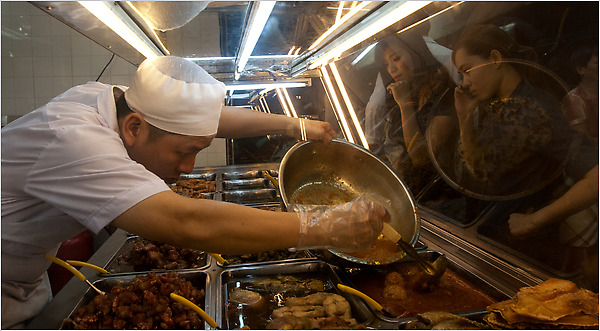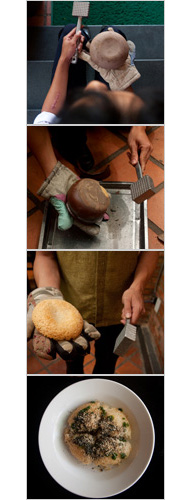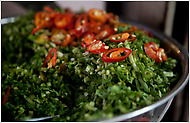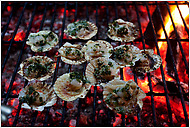
A waiter selects items from the offerings at Minh Duc, a restaurant in the center of Ho Chi Minh City.
(Arantxa Cedillo for The New York Time)
“You like congealed pigs’ blood?” my travel companion asked, pulling me over to a street cart in Ho Chi Minh City. Before I could answer, two bowls of chao, a rice porridge bobbing with slices of pork sausage and cubes of coagulated blood, were plopped in our hands.
Pigs’ blood porridge isn’t something I’d normally try. I may not have even wandered over to see what was cooking in the streetside cauldron on wheels. But then again, I wasn’t on this culinary trek with any ordinary traveler. I was with Michael Huynh (pronounced “win”), a New York chef and restaurateur who was taking me on an eating tour of his native city.
Cooking, you might say, is in Mr. Huynh’s blood. He grew up in the kitchen at his mother’s restaurant in Ho Chi Minh City, which residents still call Saigon. Now 45, Mr. Huynh, who is better known by his nickname, Bao, reigns over a mini-empire of Vietnamese restaurants in New York City. In the last year alone, he’s staked a claim as one of New York’s most prolific chefs. (His tricks, he says, are that his menus are set at recession-friendly prices and that he can negotiate a lease in his favor.)
My journey with Mr. Huynh actually began thousands of miles away, at his new Lower East Side Vietnamese beer garden, Bia. During my visit — research for my trip — I was pleasantly surprised to find the frenetic Mr. Huynh at Bia. I asked where I should eat while in Ho Chi Minh City. “Why don’t I take you to my favorite places myself,” he said. I thought he was joking, but it turned out he was headed to his hometown to scout locations for a new restaurant (surprise, surprise) when I was going to be there.
Our tour, he told me when I met with him one more time before the trip, wouldn’t necessarily be hitting the city’s “it” restaurants. Instead, we would eat our way through Mr. Huynh’s version of the city, stopping at the places he goes to when in town, his tried-and-true spots.
What Ho Chi Minh City, the country’s biggest metropolis, lacks in aesthetics, it makes up for in chaotic energy and, of course, in its cuisine, both of which seem to be ubiquitous. Amid an incongruent jumble of low-lying buildings, its narrow streets and tiny alleys overflow with no-frills restaurants that open onto the sidewalk and look as if they could double for someone’s garage. Seemingly on every corner are portable carts powered by a gas burner and an old woman who, in many cases, is the umpteenth generation to stir that very pot. Patrons sit on low-rise stools or plastic child-size chairs in these makeshift dining spots, hunched over bowls of noodles.
 |
| At Com Nieu Sai Gon, rice is cooked in a clay pot, which is then broken open, leaving a crispy patty. |
 |
| Red chilies play a prominent role in Vietnamese food. |
 |
| Shellfish on the grill at Lang Nuong Nam Bo, which specializes in barbecue. |
Mr. Huynh and I were to arrive the same day, but given his hectic schedule, I wasn’t surprised when he called me just before I was boarding my flight to say he was coming the following day. Three days later, he finally turned up. True to his word, he wasted no time introducing me to his native city’s cuisine.
After beginning with the pig’s blood porridge — we paid less than a dollar for the two of us — we headed for District 3, a neighborhood outside the city center. Our destination, Com Nieu Sai Gon, he told me, is beloved by locals and is increasingly on the radar of food-focused tourists. Its former owner, Madame Ngoc, became well-known with travelers after appearing on Anthony Bourdain’s travel show “No Reservations” in 2005. Madame Ngoc has since passed on, but her restaurant continues to pack in the diners.
Once seated, Mr. Huynh hardly glanced at the 300 or so items on the menu before spitting out a long order for our waiter. Meanwhile, the sound of shattering pots rang throughout the restaurant. The reason wasn’t clumsiness. It turned out that the house specialty, rice cooked in a clay pot, is served after a ritual you aren’t likely to find in New York: before serving, waiters break the clay pots and then scrape out the crispy patties of rice that remain.
To ensure there are no lingering shards of clay, glove-clad waiters toss the rice patties across the room to each other before depositing them on diners’ tables and sprinkling them with a scallion-spiked sauce. (According to Richard Sterling, a friend who lives in Ho Chi Minh City and wrote Lonely Planet’s “World Food: Vietnam,” this is an ancient tradition in Southeast Asia, but one that is rarely performed these days.) As the baked rice landed on our table, a waiter showed me a scar on his thumb from breaking a pot, a hazard of the job.
A few minutes later, a procession of dishes began arriving: Japanese eggplant, sautéed with enough garlic to take out a vampire; steamed blood cockles; caramelized fish hatchlings cooked in a clay pot; and lotus root salad. All were washed down with a bia da, beer with ice, a time-honored southern Vietnam tradition.
But Mr. Huynh, I would quickly learn, never settles for just one meal. Every time we met, whether for breakfast, lunch or dinner, we’d make several stops, snacking our way down the street. Sometimes we’d slurp up a bowl of pho before he’d guide me down alleyways for one of the many variations on the theme of bun (pronounced “boon”), a vermicelli noodle bowl filled with pork and veggies.
Then we’d stop at a cart for sticky rice or a pork-crammed banh mi sandwich and then, finally, sit down on a sidewalk stool for a dosa-like shrimp-and-pork-stuffed banh xeo. (Whether we were eating street food or at a restaurant, the meal for two, plus a couple of beers, rarely exceeded $20.) “The most authentic food in Saigon is at street carts and simple restaurants,” he said during one of our multi-stop extravaganzas.
One day, while Mr. Huynh had a business meeting, I stopped into the Black Cat, a restaurant owned by a friend of a friend, Geoffrey Deetz, originally from the Bay Area. Over cold bottles of Vietnamese beer, he took my guide’s comments a step further: “It’s more about style than substance at the new trendy restaurants,” he said, explaining that most Vietnamese chefs have yet to successfully elevate traditional cuisine. As Vietnam’s robust economy continues to grow and newly built skyscrapers devour blocks that once offered no-frills food options, finding decent dining in the central District 1 is becoming a challenge.
Unless, of course, you’re with Mr. Huynh. The following day, he took me to Minh Duc, in the city center. The restaurant, which features simple décor and communal metal tables, offers yet another surprising form of entertainment: the open-to-the-street dining room is across a busy road from the kitchen, so while Mr. Huynh and I munched on a feast of simply prepared dishes, we watched a steady stream of tray-carrying waiters carefully play a real-life version of the classic arcade game Frogger, struggling to cross the scooter-crammed street. Once it arrived, though, the food was the real star of the show.
“You can’t eat like this in America,” said Mr. Huynh, scanning the table. “Vietnamese food is similar to Chinese, but the difference is that we cook food slower,” he said. Case in point: the caramelized pork belly was so tender it came apart in chunks when my chopsticks hit it. The braised catfish was equally tender — Mr. Huynh instructed me to eat the belly first, which was soft and rich and melted when it hit the tongue.
On another night, after our usual impromptu stops at food carts for sticky rice or a glass of mung bean milk, we took a taxi out to District 10 to dine at Lang Nuong Nam Bo, one of a handful of restaurants in Ho Chi Minh City that specialize in Mekong Delta-style barbecue. Diners prepare their own meat on miniature charcoal grills at each table. Crates of beer are left at diners’ feet, along with a bottle opener on the table.
As waiters wandered by, plopping big chunks of ice in our beer mugs, we snacked on small embryonic duck eggs. Then the raw meat began arriving: wild boar, then goat breast. Mr. Huynh carefully flipped the meat on the grill until he determined it was done. Both were smoky and tender. Finally, a surprise: Mekong rat, a delicacy in the south. Mr. Huynh said he wouldn’t eat it, but refused to say why, leaving the flattened, just-grilled rat on a plate staring at me. I gave it a go. There wasn’t much meat, but it was edible: chewy, dark and well-charred.
Several beers and small mammals later, our clothes reeking of smoked meat, we paid the bill and jumped in a cab, directing the driver back to District 1. Tomorrow would be a new day, and I had a feeling that meant another marathon, eating our way through the city’s chaotic food-strewn streets.
IF YOU GO
GETTING THERE
There are no nonstop flights from the United States to Ho Chi Minh City. A recent Web search yielded Cathay Pacific (cathaypacific.com) flights out of Kennedy Airport in New York, with a change in Hong Kong, starting at about $1,200, for travel in April.
WHERE TO EAT
Com Nieu Sai Gon (6C Tu Xuong Street, District 3, 84-8 3-932-6388).
Minh Duc (100 Ton That Tung Street, District 1; 84-8 3-839-2240; tiemcomminhduc.com).
Lang Nuong Nam Bo (285 Cach Mang Thang Tam Street, District 10; 84-8 3-863-2309).
WHERE TO STAY
If you want to follow the Michael Huynh trail, stay at the Sunflower Hotel (84A Bui Thi Xuan Street; 84-8 3-925-7458; sunflowerhotel.vn), his home-away-from-home when he’s in town. doubles from $40; Wi-Fi, breakfast and cable TV are included.
The new 19-story Intercontinental Asiana Saigon (39 Le Duan Boulevard, District 1; 84-8 3-520-9999; ichotelsgroup.com/intercontinental/en/gb/locations/hochiminhcity) offers 305 rooms and suites, most with city views; doubles from $195.
